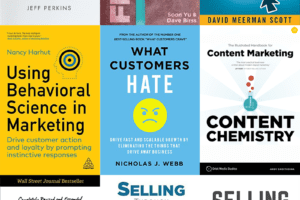???? Episode 98 of Yes, and Marketing
Marketing and sales go hand in hand, but not nearly enough marketers really understand how sales works.
Lee Salz is a best-selling author, speaker, and sales management strategist. His book Sell Different! was named the best sales book of 2021 by Doug Burdett of the Marketing Book Podcast, and on this episode, he shares an inside look at everything marketers need to know about sales:
- The difference between marketing differentiation and sales differentiation
- Whether prospecting is dead
- The role of discovery
- The problem with ICPs
- The one opportunity 99.999% of salespeople are missing
Listen to the full interview above or read on for our highlights from the conversation. You can also view excerpts from all our episodes on our show page.
???? Guest-at-a-Glance
Name: Lee Salz
What he does: Founder of Sales Architects and best-selling author of Sell Different! and Sales Differentiation.
Find Lee on the web: Sales Architects | The book | Lee’s Lessons | LinkedIn | Twitter
Get smart: “If you don’t believe what you’re selling is worth the price tag on it, go sell something else.”
???? Episode Highlights
Read verbatim excerpts from our interview with Lee Salz.
Marketing differentiation vs. sales differentiation
“Marketing differentiation is one-directional communication for the masses. It says, ‘Hey, look at us, we’re here,’ right? If you think about it, your website, if you do a trade show—it lays out all the potential of what could be, and all the capabilities that your company could bring.
Sales differentiation is two-directional communication with an individual. Everyone buys for a different reason, so sales differentiation gives you the tools to take all the potential of what could be, and narrow it down to what should be for this individual in this circumstance.”
Collaboration leads to consistency
“Marketing shouldn’t drive sales, sales shouldn’t drive marketing. It’s a collaboration. They need to be on the same page, so that if we take that other entity called ‘the buyer,’ they’re having consistency of impression. If I go on the website, if I meet with one of your salespeople or talk with them in a virtual environment, it’s all reinforcing the same messages.”
A salesperson’s biggest complaint
“One of the biggest complaints I hear from salespeople is, ‘I’m talking to prospects and clients all day long and no one asks me what I’m seeing and hearing in the field,’ and so that’s not accounted for in the marketing strategy. It’s not even accounted for oftentimes in the sales strategy.”
Discovery is the foundation of a sale
“Discovery is where you capture key information, and you share and position your differentiators. This is the foundation of the sale. And if you think of it in terms of a home, if the foundation is weak, the home is going to collapse.
Same thing with the sale. If the foundation is weak, you’re going to have problems and you’re going to see it at the finish line, when you don’t have the tools to keep the deal energized.”
Turning discovery into a finite project plan
“If you think of this in terms of a marathon, if we start by developing the list of questions and message points, we’re at the starting line, but let’s jump to the finish line and ask ourselves this question: ‘It was a great meeting if we accomplished what? What does success look like?’
Let’s develop a portfolio of outcomes. And once we have that list, the questions we’re going to ask—the information—is a subset of the outcomes. We’re only going to ask questions that tie to the outcomes that we’re looking for. We’re only going to share information that helps us achieve the outcomes that we’ve identified.”
Know whether a pain point is an inconvenience or a problem
“When you hear that pain point, is it an inconvenience or is it a problem? And those aren’t synonyms. When you think of an inconvenience, we all have them. They’re nuisances. We deal with it. We live with it. We complain about it to anybody who listen, but we don’t do anything about it. Only when something elevates to the level of a problem, are we willing to invest time, resources, and dollars.”
Find the evidence
“‘Why should they want to have a conversation with you right now?’ That’s what every salesperson should be looking for. Not, why should we talk with them? That would be egocentric. ‘Why should they want to have a conversation with me right now?’
So the first thing we need to do is identify the types of sales crime theory evidence that if we came across it, would say, ‘Ah, they should want to have a conversation with me right now.’ Let’s say, for example, we sell technology for conferences. So, what types of evidence, if we came across it, would say they should want to have a conversation with me right now?
Let’s say a new CIO is hired. Maybe even a new CEO is hired, an acquisition, a relocation, expansion—if any of those things are going on, there’s probably a conversation taking place about the technology that’s in their conference rooms. And since that’s what I sell, they should want to talk with me.”
Prospecting is not dead
“A consultancy called the RAIN Group conducted a study. They asked executives if they had ever taken a meeting with a salesperson that had reached out to them through some form of prospecting. The result was 82%. Most salespeople if I ask them, they gave me a small single-digit number, some as low as zero.
82%—better than four out of five executives—said they took a meeting with a salesperson that had reached out to them through some form of prospecting, but the study went a step further. They found the key ingredient, the secret sauce to getting that meeting, which was personalization. If we’re sending generic emails, leaving generic voicemails, having generic conversations, we’re not going to be in that four out of five group.”
Have a target, not an ideal
“Ideal client profile says, if all the stars were to align, this is the kind of business we’d love to have. It’s like winning the lottery.
…What every salesperson should have is a target client profile, and that’s needed for every product that you sell. Target client profile says, this is who will see meaningful value in what we’re offering. And every selling minute of every day should be in the pursuit of those types of opportunities.”
The problem with a prospect’s memory…
“Imagine you had this discovery, and it meets the criteria that we talked about earlier. It was a great discovery meeting. We checked all the boxes for us, they ate up your differentiators, they had challenges that you can address. You’ve got action items, they’ve got action items, the deal’s so good you could taste it. And as you’re walking back to your car or you’re turning off Zoom, that meeting plays in your head like your favorite movie.
And here’s the flaw: It’s that we think they remember that meeting just as vividly as we do. It doesn’t dawn on us that after our meeting, they had seven other meetings, 120 emails, 16 voicemail messages, each one of them layering on top of our meeting, making it a distant memory.”
…and what to do about it
“Here’s the opportunity that over 99.999% of salespeople miss out on, and that’s the recap email. This is an email that you send out within 24 hours of your discovery. It has five sections.
The first one is your objectives: what they said, they’re looking to accomplish. Use their words whenever possible, so that they read it and they’re like, ‘Yep, yep, yep. He heard me, he heard me.’
‘How we can help’ is section two—opportunity to remind them in written form of those meaningful differentiators that they love so much.
‘My action items’—what I said I’m going to do.
‘Your action items,’ which you said you’re going to do.
And ‘Our agreed upon next step.’
You lay this all out in a nice narrative email—you can use bullet points in each of the sections—and you send this to them. And a few things happen from that: Number one, there’s no CRM on the planet that will produce that for you. You have to do it manually. They know that, so you’re showing genuine interest in them and in the account.
CEB, which is now Gartner, says 6.8 people are involved in a typical B2B sale. You met with one person. You write this email in such a way it can be shared with the other 5.8 so they’re brought up to speed and they get just as excited as their colleagues.”
????️ Lee Salz Quotes
“I always told employers on day one, ‘I don’t care how much money I’m making. If I have to use an alarm clock to get up, I’m going to hand you the keys and say, thank you very much and walk out.’ Gotta be fired up.”
“There’s confusion between a pipeline and a pipe dream.”
“When it comes to sales, the needle is way too far on the passive side that we don’t make enough attempts—and then, taking it a step further, different attempts.”
“Very early on in my career, one of the takeaway messages was having clarity on who perceives meaningful value in what you’re selling.”
“When you talk about price, that’s one of the first clarification points we’ve got to know—who will perceive meaningful value in what we’re selling—and not waste our time chasing mirages.”
“If you don’t believe what you’re selling is worth the price tag on it, go sell something else.”
???? Learn More
Head to targetclientprofile.com and download a template to help identify your brand’s target clients.
Lee mentioned Herman Ebbinghaus’s discovery of the ‘forgetting curve’ when stressing the importance of sending prospects a recap email.



